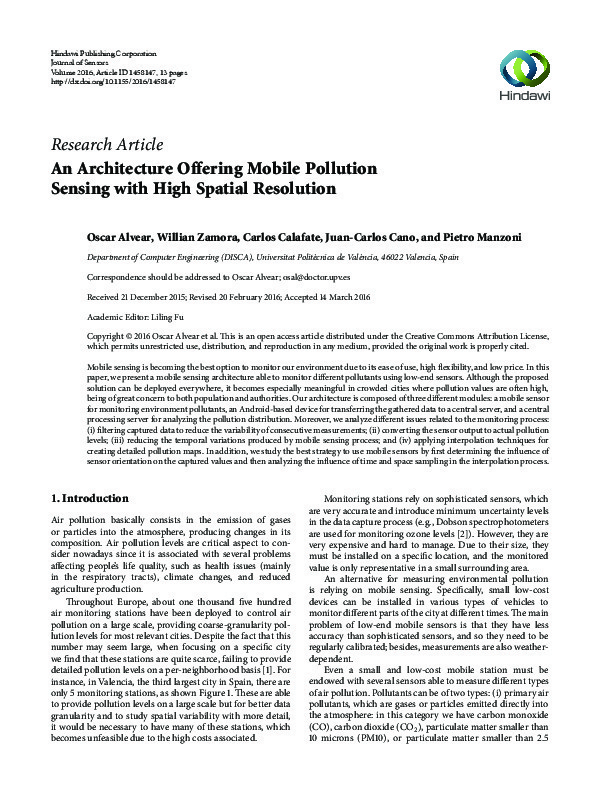JavaScript is disabled for your browser. Some features of this site may not work without it.
Buscar en RiuNet
Listar
Mi cuenta
Estadísticas
Ayuda RiuNet
Admin. UPV
An Architecture Offering Mobile Pollution Sensing with High Spatial Resolution
Mostrar el registro sencillo del ítem
Ficheros en el ítem
| dc.contributor.author | Alvear-Alvear, Óscar
|
es_ES |
| dc.contributor.author | Zamora-Mero, Willian Jesus
|
es_ES |
| dc.contributor.author | Tavares de Araujo Cesariny Calafate, Carlos Miguel
|
es_ES |
| dc.contributor.author | Cano Escribá, Juan Carlos
|
es_ES |
| dc.contributor.author | Manzoni, Pietro
|
es_ES |
| dc.date.accessioned | 2017-03-06T10:04:57Z | |
| dc.date.available | 2017-03-06T10:04:57Z | |
| dc.date.issued | 2016 | |
| dc.identifier.issn | 1687-725X | |
| dc.identifier.uri | http://hdl.handle.net/10251/78509 | |
| dc.description | © 2016 Oscar Alvear et al. This is an open access article distributed under the Creative Commons Attribution License, which permits unrestricted use, distribution, and reproduction in any medium, provided the original work is properly cited. | es_ES |
| dc.description.abstract | Mobile sensing is becoming the best option to monitor our environment due to its ease of use, high flexibility, and low price. In this paper, we present a mobile sensing architecture able to monitor different pollutants using low-end sensors. Although the proposed solution can be deployed everywhere, it becomes especially meaningful in crowded cities where pollution values are often high, being of great concern to both population and authorities. Our architecture is composed of three different modules: a mobile sensor for monitoring environment pollutants, an Android-based device for transferring the gathered data to a central server, and a central processing server for analyzing the pollution distribution. Moreover, we analyze different issues related to the monitoring process: (i) filtering captured data to reduce the variability of consecutive measurements; (ii) converting the sensor output to actual pollution levels; (iii) reducing the temporal variations produced by mobile sensing process; and (iv) applying interpolation techniques for creating detailed pollution maps. In addition, we study the best strategy to use mobile sensors by first determining the influence of sensor orientation on the captured values and then analyzing the influence of time and space sampling in the interpolation process. | es_ES |
| dc.description.sponsorship | This work was partially supported by the "Programa Estatal de Investigacion, Desarrollo e Innovacion Orientada a Retos de la Sociedad, Proyecto I+D+I TEC2014-52690-R," the "Universidad Laica Eloy Alfaro de Manabi," and the "Programa de Becas SENESCYT de la Republica del Ecuador." | en_EN |
| dc.language | Inglés | es_ES |
| dc.publisher | Hindawi Publishing Corporation | es_ES |
| dc.relation.ispartof | Journal of Sensors | es_ES |
| dc.rights | Reconocimiento (by) | es_ES |
| dc.subject | Mobile Pollution Sensing | es_ES |
| dc.subject | Kriging | es_ES |
| dc.subject | Interpolation | es_ES |
| dc.subject | Android | es_ES |
| dc.subject | Ozone | es_ES |
| dc.subject.classification | ARQUITECTURA Y TECNOLOGIA DE COMPUTADORES | es_ES |
| dc.title | An Architecture Offering Mobile Pollution Sensing with High Spatial Resolution | es_ES |
| dc.type | Artículo | es_ES |
| dc.identifier.doi | 10.1155/2016/1458147 | |
| dc.relation.projectID | info:eu-repo/grantAgreement/MINECO//TEC2014-52690-R/ES/INTEGRACION DEL SMARTPHONE Y EL VEHICULO PARA CONECTAR CONDUCTORES, SENSORES Y ENTORNO A TRAVES DE UNA ARQUITECTURA DE SERVICIOS FUNCIONALES/ | es_ES |
| dc.rights.accessRights | Abierto | es_ES |
| dc.contributor.affiliation | Universitat Politècnica de València. Escola Tècnica Superior d'Enginyeria Informàtica | es_ES |
| dc.contributor.affiliation | Universitat Politècnica de València. Departamento de Informática de Sistemas y Computadores - Departament d'Informàtica de Sistemes i Computadors | es_ES |
| dc.description.bibliographicCitation | Alvear-Alvear, Ó.; Zamora-Mero, WJ.; Tavares De Araujo Cesariny Calafate, CM.; Cano Escribá, JC.; Manzoni, P. (2016). An Architecture Offering Mobile Pollution Sensing with High Spatial Resolution. Journal of Sensors. 2016:1-13. https://doi.org/10.1155/2016/1458147 | es_ES |
| dc.description.accrualMethod | S | es_ES |
| dc.relation.publisherversion | https://www.hindawi.com/journals/js/2016/1458147/ | es_ES |
| dc.description.upvformatpinicio | 1 | es_ES |
| dc.description.upvformatpfin | 13 | es_ES |
| dc.type.version | info:eu-repo/semantics/publishedVersion | es_ES |
| dc.description.volume | 2016 | es_ES |
| dc.relation.senia | 307741 | es_ES |
| dc.contributor.funder | Ministerio de Economía y Competitividad | es_ES |
| dc.contributor.funder | Secretaría de Educación Superior, Ciencia, Tecnología e Innovación, Ecuador | es_ES |
| dc.contributor.funder | Universidad Laica Eloy Alfaro de Manabi | es_ES |








